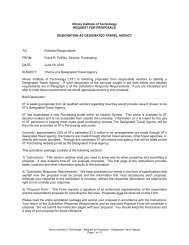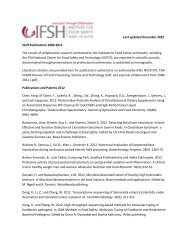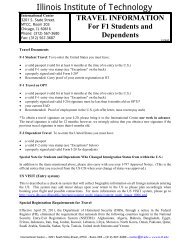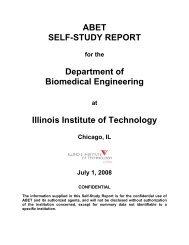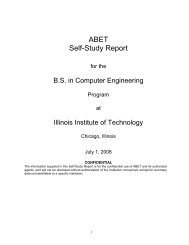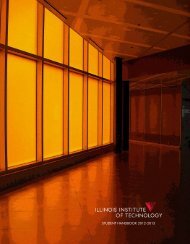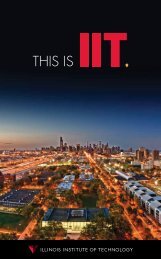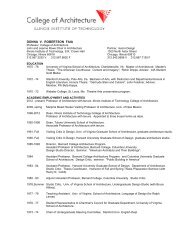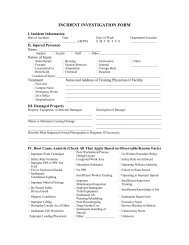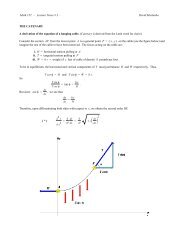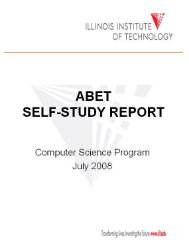Copyright & Disclaimer Information - Illinois Institute of Technology
Copyright & Disclaimer Information - Illinois Institute of Technology
Copyright & Disclaimer Information - Illinois Institute of Technology
Create successful ePaper yourself
Turn your PDF publications into a flip-book with our unique Google optimized e-Paper software.
Course Descriptions<br />
Biology<br />
BIOL 100<br />
Introduction to the Pr<strong>of</strong>ession<br />
Introduction to the biological sciences,<br />
scientific method, computing tools, and<br />
interrelations <strong>of</strong> biological sciences with<br />
chemistry, physics and other pr<strong>of</strong>essions.<br />
(2-0-2) (C)<br />
BIOL 107<br />
General Biology Lectures<br />
This course emphasizes biology at the<br />
organismal level. It provides an introduction<br />
to the study <strong>of</strong> the structure<br />
and function <strong>of</strong> plants and animals,<br />
their origin and evolution, their reproduction<br />
and genetics, their diversity<br />
and ecological relations. BIOL 107 and<br />
109 plus BIOL 115 and BIOL 117<br />
constitutes a one-year sequence in biology.<br />
Acceptable as part <strong>of</strong> the science<br />
component <strong>of</strong> the General Education<br />
Program. (3-0-3)<br />
BIOL 109<br />
General Biology Laboratory<br />
A laboratory course to accompany<br />
BIOL 107. Prerequisite: Concurrent<br />
or previous enrollment in BIOL 107.<br />
(0-4-2) (C)<br />
BIOL 115<br />
Human Biology<br />
This course covers selected topics in biology<br />
<strong>of</strong> particular relevance to humans<br />
and to human health and disease. Topics<br />
include biology <strong>of</strong> human cells and<br />
selected organ systems; neurobiology<br />
including psychoactive drugs and drug<br />
addiction; development and birth<br />
defects; genetics and genetic diseases;<br />
toxicology; the immune system and<br />
immunologic diseases such as AIDS;<br />
human nutrition and nutritional<br />
effects; and microbial human diseases.<br />
BIOL 115 plus BIOL 107 (General<br />
Biology) constitutes a two-semester<br />
sequence in science. (3-0-3)<br />
BIOL 117<br />
Experimental Biology<br />
A biology laboratory course to accompany<br />
BIOL 115. A cellular approach to<br />
the functional organization <strong>of</strong> organs<br />
and organ systems. Laboratories will<br />
include the application <strong>of</strong> experimental<br />
methods and techniques for understanding<br />
the relationships between cell<br />
function and structure. (0-4-2) (C)<br />
<strong>Copyright</strong> & <strong>Disclaimer</strong> <strong>Information</strong>: <strong>Copyright</strong> © 1994, 1995, 1996, 1997, 1998, 1999, 2000, 2001, 2002, 2003, 2004, 2005, 2006, 2007. CollegeSource®, Inc. and Career Guidance Foundation. CollegeSource® digital catalogs are derivative works owned and copyrighted by CollegeSource®, Inc. and Career Guidance Foundation. Catalog content is owned and copyrighted by the appropriate school. While CollegeSource®, Inc. and Career Guidance Foundation provides information as a service to the public, copyright is retained on all digital catalogs.<br />
<strong>Copyright</strong> & <strong>Disclaimer</strong> <strong>Information</strong>: <strong>Copyright</strong> © 1994, 1995, 1996, 1997, 1998, 1999, 2000, 2001, 2002, 2003, 2004, 2005, 2006, 2007. CollegeSource®, Inc. and Career Guidance Foundation. CollegeSource® digital catalogs are derivative works owned and copyrighted by CollegeSource®, Inc. and Career Guidance Foundation. Catalog content is owned and copyrighted by the appropriate school. While CollegeSource®, Inc. and Career Guidance Foundation provides information as a service to the public, copyright is retained on all digital catalogs.<br />
BIOL 210<br />
Microbiology Lectures<br />
A study <strong>of</strong> microorganisms and their<br />
relation to water, sanitation, soil, disease,<br />
biotechnology, bioremediation,<br />
bioinformatics and genetic engineering.<br />
Prerequisite: BIOL 107 or BIOL 115<br />
or equivalent. (3-0-3)<br />
BIOL 214<br />
Genetics and Genetic <strong>Technology</strong><br />
An introduction to genetic engineering<br />
and genetics designed for both biology<br />
and other science majors. The course<br />
will focus on how the study <strong>of</strong> genetics<br />
has been adapted, from contemporary<br />
recombinant DNA research to the solution<br />
<strong>of</strong> various practical problems in<br />
biotechnology, agriculture, the environment<br />
and the diagnosis and treatment<br />
<strong>of</strong> disease. Basic aspects <strong>of</strong> transmission,<br />
molecular and population genetics will<br />
serve as the background. Prerequisite:<br />
One semester <strong>of</strong> college-level biology,<br />
e.g., BIOL 107 or 115, or consent<br />
<strong>of</strong> the instructor. (3-0-3)<br />
BIOL 225<br />
Microbiology Laboratory<br />
Isolation and identification <strong>of</strong> microorganisms,<br />
microbial growth, design<br />
<strong>of</strong> culture media, microorganisms as biocatalysts,<br />
environmental microbiology,<br />
quantitative microbiology, introduction<br />
to microbial genetics, and genetic engineering.<br />
Prerequisites: Concurrent or<br />
previous enrollment in BIOL 210 or<br />
consent <strong>of</strong> instructor. (0-4-2) (C)<br />
BIOL 301<br />
Literature Survey/MCAT Preparation<br />
A course to familiarize pre-med students<br />
with the biology literature and<br />
prepare them for MCAT examinations.<br />
(1-0-1)<br />
BIOL 320<br />
Biological Literature<br />
Library research on an advanced topic<br />
in biology, directed by a faculty member.<br />
(0-4-2) (C)<br />
BIOL 403<br />
Biochemistry Lectures<br />
Molecular organization <strong>of</strong> cell structures<br />
and cell membranes. Proteins,<br />
nucleic acids, carbohydrates and lipids,<br />
their molecular structure, characterization<br />
and chemical reactions. Enzymes<br />
and enzyme-catalyzed reactions and<br />
IIT Undergraduate Bulletin 1999-2001<br />
metabolism. Prerequisite: BIOL 107 or<br />
BIOL 115 and CHEM 237. (4-0-4)<br />
BIOL 404<br />
Biochemistry Laboratory<br />
Analytical methods in the chemistry<br />
and metabolism <strong>of</strong> proteins, amino<br />
acids and nucleic acids, including<br />
chromatography, spectrophotometry<br />
and electrophoresis. Enzyme reactions.<br />
Prerequisite: Previous or concurrent<br />
enrollment in BIOL 403. (0-6-3) (C)<br />
BIOL 414<br />
Genetics for Engineering Scientists<br />
A course in genetics and genetic engineering<br />
designed for advanced students<br />
in engineering and related disciplines.<br />
The course will cover genetics at the<br />
molecular, cellular, organismal, and population<br />
levels as a basis for discussions <strong>of</strong><br />
practical applications <strong>of</strong> recombinant<br />
DNA technology in industry and the<br />
fields <strong>of</strong> medicine, agriculture, etc. A<br />
term paper will be required in addition<br />
to in-class examinations. Prerequisite:<br />
Consent <strong>of</strong> the instructor. (3-0-3) (C)<br />
BIOL 423<br />
Microbial Genetics Laboratory<br />
Quantitative techniques in microbial<br />
genetics including mutagenesis, isolation<br />
and characterization <strong>of</strong> mutants,<br />
hybridization, random spore analysis<br />
and gene complementation. Basic techniques<br />
used in recombinant DNA<br />
technology (genetic engineering) will<br />
include restriction enzyme analysis and<br />
mapping, cloning <strong>of</strong> DNA fragments<br />
into plasmid vectors, transformation<br />
<strong>of</strong> cells with recombinant DNA, isolation<br />
and analysis <strong>of</strong> recombinant<br />
plasmids, Southern blotting and PCR.<br />
Prerequisites: BIOL 210, BIOL 225,<br />
BIOL 403. (1-6-3) (C)<br />
BIOL 430<br />
Animal Physiology<br />
Respiration; circulation; energy metabolism;<br />
temperature regulation; water<br />
and osmotic regulation; digestion and<br />
excretion; muscle and movement; nerve<br />
excitation; information control and<br />
integration; and chemical messengers.<br />
Emphasis on general principles with<br />
examples drawn from various animal<br />
phyla. Prerequisite: BIOL 107 or BIOL<br />
115. (3-0-3)



